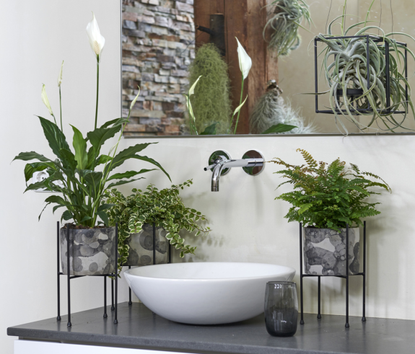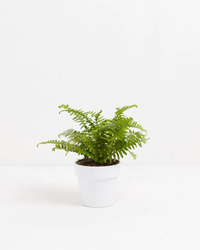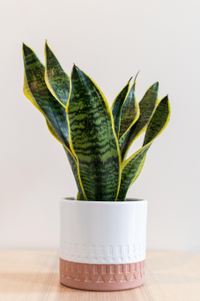Can houseplants prevent mold? These humidity-loving varieties might just be the best remedy for damp spaces
If recurring mold is a problem in your home, introducing one of these humidity-loving houseplants might be the answer


At this point in February, winter feels eternal. The cold and damp conditions outside have most likely crept inside your home making it difficult to ventilate your space. As a result, dreaded specks of mold may have found their way into the corners of your rooms or windowsills. Before you splash the cash on harsh chemical sprays to tackle it, however, houseplants could be the natural remedy you need.
There are many plant varieties out there that are lovers of humid environments and act as natural air purifiers. If recurring mold is a problem for you through these colder months of the year and you've already ruled out any serious structural issues that could be the cause, then introducing a few humidity-loving houseplants might be the answer. The best part is, many of them are suitable houseplants for beginners too, so even the less green-thumbed among us can embrace this green solution.
'Houseplants are a great natural way of helping with issues of mold within the home by bringing the moisture levels down in the air,' says interior landscape designer, Ian Drummond. 'They work particularly well in bathrooms and kitchens by helping control humidity levels by absorbing moisture through their leaves.' To find out more, we spoke with some plant experts to find out which of our leafy friends are best for the job.

Ian Drummond is an interior landscape designer and author. Ian has been at the forefront of the indoor plants revival in recent years and has won multiple gold medals at the RHS Chelsea Flower for his indoor gardens. His book, At Home with Plants, is published by Octopus Books.
It's worth noting that, in order to efficiently reduce humidity in a room and reduce the risk of mold, a dehumidifier will always be best.
'While there are some plants that can help reduce humidity by absorbing moisture from their leaves you would need a lot of plants in order to efficiently reduce the humidity levels in a space,' notes Paris Lalicata, plant expert at The Sill. She even points out that a lot of plants in one space can in fact cause humidity levels in your room to rise.
'Generally though, any plants that love higher humidity can absorb water vapor from the air,' she says. 'Below are a few examples of plants that love higher humidity.'
Boston Fern

Boston ferns are an air-purifying Feng Shui plant that flourishes in humid spots in your home. Also sometimes referred to as the sword fern, this stylish houseplant is native to Florida, South America, Polynesia, and Africa, meaning it enjoys warm but moist conditions. 'In fact, any type of fern will be a great choice for a home with mold issues as they thrive on high humidity,' says Ian Drummond.
The green fronded friend has bushy, feather-like leaves that can absorb moisture from the air, making it perfect for damp windowsills, bathrooms, or kitchens where mold is a common problem. 'Since ferns love having higher humidity around them they can absorb the water vapor in the air, especially thinner leaf varieties that don't have a waxy texture on the leaves,' Paris explains.

Boston Fern, Lively Root
Bushy and beautiful, the humidity-loving Boston fern will add fairy-tale woodland charm to any space. These natural air purifiers work wonders in kitchens and bathrooms to suck up moisture, and look especially striking in a hanging container
Peace Lily

Originating from the rainforests of South America, the Peace Lily loves moist and misty conditions, making it one of the best plants for bathrooms. This also makes it one of the best plants for cleaning the air and absorbing moisture, helping to curb the spread of mold. It isn't a fan of cold temperatures however, so it's best to keep it away from a window in the winter even if that's where you've noticed mold forming.
'The larger the plant, the more effective it will be at removing the mold,' says Angela Slater, plant expert at Hayes Garden World. 'The Peace Lily is also effective at removing airborne toxins and swapping carbon dioxide for life-giving oxygen.'
Snake Plant

Despite being part of the succulent family native to the desert, the snake plant loves a humid spot, but be careful not to overwater it. When it comes to caring for a Snake Plant these spikey-looking plants love to be neglected.
Angela recommends buying a large specimen or a group of snake plants to maximize their moisture-absorbing benefits. 'Not only is a group more effective at removing mold, but it's also more aesthetically pleasing,' she says. As well as helping to reduce mold, this low-maintenance houseplant also removes airborne toxins.

Snake Plant, The Sill
This houseplant staple, also known as Mother-in-Law's Tongue, is loved for being extremely low maintenance and for its ability to purify the air. Its upright sword-like leaves with vibrant yellow edges, often variegated, look extra beautiful when given the occasional polish.
English Ivy

One of the best trailing houseplants out there with its beautiful evergreen foliage, the English Ivy is a bit of a wonder plant. It's one of the easiest leafy accessories to look after making it perfect for first-time plant parents, and it has miraculous mold-preventing powers too.
'The English Ivy is an ideal plant for the bathroom or kitchen as it thrives in a humid atmosphere,' Angela explains. 'Studies have found that it's effective at removing airborne benzene, trichloroethylene and formaldehyde as well as mold.'
Be The First To Know
The Livingetc newsletter is your shortcut to the now and the next in home design. Subscribe today to receive a stunning free 200-page book of the best homes from around the world.

Lilith Hudson is the News Editor at Livingetc, and an expert at decoding trends and reporting on them as they happen. Writing news, features, and explainers for our digital platform, she's the go-to person for all the latest micro-trends, interior hacks, and color inspiration you need in your home. Lilith discovered a love for lifestyle journalism during her BA in English and Philosophy at the University of Nottingham where she spent more time writing for her student magazine than she did studying. After graduating, she decided to take things a step further and now holds an MA in Magazine Journalism from City, University of London, with previous experience at the Saturday Times Magazine, Evening Standard, DJ Mag, and The Simple Things Magazine. At weekends you'll find her renovating a tiny one-up, one-down annex next to her Dad's holiday cottage in the Derbyshire dales where she applies all the latest design ideas she's picked up through the week.
-
 The 12 Best Table Lamps for Reading —I'm a Certified Bookworm (and Shopping Expert)
The 12 Best Table Lamps for Reading —I'm a Certified Bookworm (and Shopping Expert)When it comes to table lamps for reading, I don't mess around. If you're the same, this edit is for YOU (and your books, or course — and good recommendations?)
By Brigid Kennedy Published
-
 "It's Scandi Meets Californian-Cool" — The New Anthro Collab With Katie Hodges Hits Just the Right Style Note
"It's Scandi Meets Californian-Cool" — The New Anthro Collab With Katie Hodges Hits Just the Right Style NoteThe LA-based interior designer merges coastal cool with Scandinavian simplicity for a delightfully lived-in collection of elevated home furnishings
By Julia Demer Published

